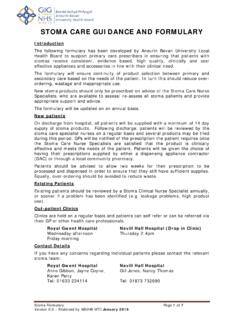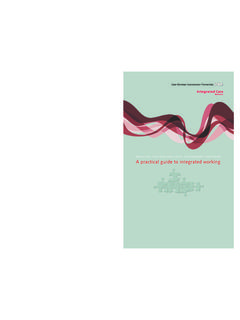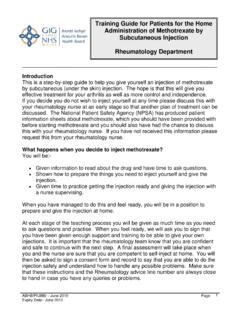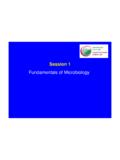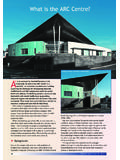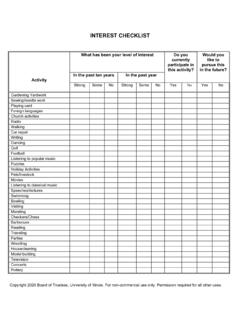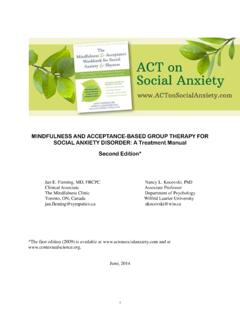Transcription of Oral Desensitisation - Wales
1 Community Paediatric Occupational Therapy Department Oral Desensitisation Introduction The following programme is designed to help children become more tolerant of sensations in their mouth. The mouth is the most sensitive area of the body and babies use this to learn about different textures. This stage of exploring is also important in helping the child to develop control of their mouth (oral motor control) the ability to suck, blow, chew etc. The child s ability to move the tongue and lips to be able feed and speak well depends on having enough sensitivity in and around their mouth. When a child is sensitive to touch it is not uncommon for the area within and around the mouth to cause the most problems. This can result in frustration for parents at meal times and brushing teeth.
2 The strategies and advice in this document offer information to parents and schools on introducing textures to a child s mouth in a graded way. This will help the child to decreasing tactile sensitivity, increase awareness of the mouth structure, Improve tongue movements and increase the ability and willingness to brush teeth at a comfortable pace. Many of the activities mentioned provide added proprioceptive and tactile sensation to the mouth. Proprioception is the information our brain received from our muscles, joints and ligaments enabling us to know where each part of our body is and how it is moving. In this instance proprioceptive information comes from the areas inside and around the mouth. Things to think about when starting to help a child become more tolerant of textures in their mouth: Control of muscles in the mouth begin with sucking and are followed by blowing, biting, crunching and then chewing.
3 Think about this order when presenting oral activities to a child. if the child has good sucking skills then choose an activity that focuses on the next stage blowing. There are no set rules on how quickly a child progresses through this programme. It is important that their tolerance to textures and oral motor skills are developed at a comfortable pace for both the child and yourself. Aim to carry out activities on a daily basis as this will help to maximize the child s ability to develop tolerance to sensations in their mouth. Exploring textures with hands is important once the child has begun to tolerate and explore different textures with their mouth. Experimenting with different temperatures will improve sensory awareness too. Getting Started Begin by sitting with the child on your lap in front of a mirror.
4 Start to apply firm pressure to the area outside the mouth and encourage the child to do the same. This deep pressure can help the child become less sensitive. You could use your hands or different materials ranging from soft and smooth to rough and bumpy. Look at how the child is reacting and encourage them to choose their favorite material. Next encourage the child to apply pressure to the roof of their mouth and gums by using their finger or a soft, round object. Gentle hand over hand assistance may be required. Figure 2: Introduce the child s finger to their mouth by placing the pad of their finger onto their lip. Figure 1: Move hands symmetrically towards the mouth. Figure 3: Introduce their finger into the mouth by rolling the finger to the inside the lip. Figure 4: Massage the gums concentrating on one part of the mouth at a time.
5 Start using this method when the child is brushing their teeth by dipping the end of the toothbrush into a small cup of flavored water. Encourage the child to hold the toothbrush and brush their tongue, teeth, inside of the cheeks and roof of the mouth. An electric toothbrush may be used to provide additional sensory information. Please use a very soft brush. Once the child is coping well with touch to their face and the inside of their mouth you can introduce the following activities, which follow the order of oral motor development mentioned previously: Sucking Drink through a straw. Make this activity more or less challenging by changing the size and length of straw. NB if sucking through a straw is difficult you can begin by encouraging the child to suck food from a finger. Drinking through a straw can be further graded by firstly drinking soft drinks such as water or squash and progressing onto thicker drinks such as milkshakes.
6 NB. if your child has any swallowing difficulties please seek advice from your speech and language therapist before attempting this activity. Suck lolli-pops or ice lollies Mini Milks. Blowing These activities will help the child learn how to force air through their mouth and improve control of their lip muscles: Blow through a straw. Again these activities can be made more or less challenging by blowing into water with soapsuds, whistles and balloons. The child can progress onto activities that require more controlled blowing blow football. Blow bubbles. If your child wants to hold the pot of bubble liquid, you can buy non spill containers with a slot for the bubble wand on top! Make music by blowing whistles, recorders etc. Biting, Crunching and Chewing Biting and tugging on tubing, pieces of liquorice, School Bars by Fruit Bowl etc.
7 Chewing crunchy food such as crackers, crisps, carrot sticks, bagels or apples. Licking Finally, licking activities for example licking lollipops, ice cream or peanut butter on a spoon may be introduced to the child, as this requires the finest tuned oral skill. Please Note: The child s speech and language therapist may be able to offer additional advice. References Erna, Botticelli & Hallway (1995) Combining Neuro-Development Treatment & Sensory Integration Principles. Oetter et al (1993) Integrating The Mouth With Sensory and Postural Functions. 2nd edition. Lane & Murray (2002) Sensory Integration Theory and Practice . Bundy. 2nd Edition. Case, Smith and Allen Sensory Profile. 3rd Edition. Page 436-439. Editorial Board: Awaiting approval Publication Date: Version: Review Date: Author: Paediatric Occupational Therapy

